


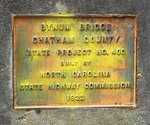
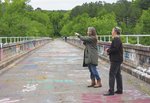
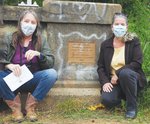
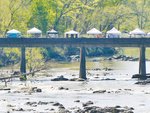
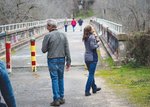
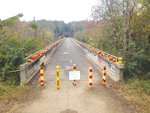
BYNUM — Sometimes a bridge is just a bridge, a utilitarian structure.
Other times, a bridge does more than merely accommodate rote traffic over an obstacle to and fro.
Sometimes, says Debbie Tunnell, a bridge is “family.”
That’s the sense of kinship she — and many others living in and around the unincorporated community of Bynum — feel for the old Bynum Bridge.
“It may sound like an unusual choice of words, but it’s family,” she said of the 98-year old concrete structure, which has enjoyed a renaissance in the 21 years since DOT engineers deemed the bridge no longer suitable for vehicles and — placing traffic blockades at its north and south sides — limited its use to only pedestrians.
“It’s not just a cement structure. It’s family to so many people,” said Tunnell, who now lives in the Miles Branch community — just a few miles from Bynum, she calls it “the suburbs” — though she remains strongly connected to the former mill village.
“From the folks who come to visit and walk across it, or who are maybe floating underneath it on their kayaks or tubes, down to the little critters that live around the bridge, it’s part of an ecosystem, and it’s family.”
That sense of family was the driving force behind an effort Tunnell and her friend Diane Swan, also a former Bynum resident now living in Miles Branch, undertook five years ago to formally recognize the value and status of the bridge.
Last month, their work — involving hundreds of hours of research and documentation — was rewarded. On April 23, the 800-foot bridge was added to the National Register of Historic Places, which the National Park Service’s website says is the agency’s “official list of historic places worthy of preservation.”
With its new designation, Bynum Bridge — also known as NCDOT Bridge #405 — joins 54 other historic Chatham County properties previously added to the Register, including two in Bynum: the Roger Joseph Moore House on Bynum Rd. and the Dr. E.H. Ward Farm.
Tunnell said the bridge’s new historic designation is important.
“It preserves the legacy of the bridge,” she said, “and of the people — the planners and engineers and builders — who made it. That bridge is a significant piece of work.”
Tunnell and Swan’s work on behalf of the bridge began in the fall of 2015, the result of a meeting of local residents who’d convened at Bynum United Methodist Church one evening to talk about local issues — growth of the surrounding area and its impact on their small community, for one — and part of the discussion focused on the old bridge. Someone that night, Tunnell recalled, referred to the structure as “orphaned and abandoned.”
“Something about that phrase — ‘orphaned and abandoned’ — just kind of stuck in our minds,” said Tunnell.
As an offshoot of the community meeting, various committees were created, including one focusing on the bridge, which Tunnell and Swan joined.
“I was really curious about the history of the bridge,” said Swan. “I started researching and the more I searched, the more I found so many fascinating historical facts.”
The committee also began “acknowledging the many ways that the bridge, although it was closed to traffic, was still being used,” Tunnell said.
With its close proximity to the Lower Haw River State Natural Area and the county-owned Bynum Beach Access Area, Bynum Bridge evolved into a focal point for a wide range of activities, gatherings and events.
“There are stargazers,” said Tunnell. “There are nature-watchers. There are people out there exercising. Families play on the bridge.”
The Chapel Hill Astronomical and Observational Society and the Bynum Astronomy Club have used it to view the dark skies. The National Audubon Society, in its February 2015 “Birders’ Guide,” shared the tip that of the many bird-watching areas in central North Carolina, “few are better than the Bynum Bridge area in Chatham County.”
For a few years, the bridge was the setting of an art show called Bridgefest. Another event, called Pumpkins on the Bridge sponsored by the community nonprofit Bynum Front Porch, is a popular Halloween event that showcases hundreds of Jack-O-Lanterns. The community landmark, more than once, has served as a wedding venue.
And, Tunnell and Swan note, the bridge is still a valuable contributor to public infrastructure, supporting “an important interconnection for water service between and the Haw River water supplies of the Town of Pittsboro and the Jordan Lake Northern Chatham County supplies .... Bynum Bridge no longer serves as a major roadway transit point, but it still connects communities and people.”
The application process for historic registration is detailed, they said. Usually submitted by professional historic preservation consultants, Tunnell and Swan undertook the work themselves.
Prior to the DOT’s decision to close the bridge to vehicles, a historic structural survey report had been prepared in 1997, which was sent to NC State Historic Preservation Officer David Brook that May. Brook concluded that, according to the report, Bynum Bridge was eligible for further study for the National Register of Historic Places because of its role in the state highway system and because the structure was a good example of reinforced concrete deck girder bridges built in the Twenties.
On November 22, 2015, Swan and Cynthia Hermans, another Bynum resident who helped with the effort, submitted another study list application for Bynum Bridge to the State Historic Preservation Office. Bynum Bridge was again accepted and added to the Study List of potential nominations to the National Register in February 2016.
Over the next few years, and under the guidance of the North Carolina Department of Cultural Resources (NCDCR) and with help and support from the broader Bynum community, Swan and Tunnell dove deep into the research, application, and approval processes on behalf of the old bridge.
The work wasn’t easy for the self-described novices.
“I think that what got me through this, besides Debbie’s consistent cheer and help,” said Swan, “was being a novice and not understanding the magnitude of what I had taken on.”
On May 16, 2018, the first draft of the “completed” application to the Historic Register for Bynum Bridge was submitted. Fine tuning of checklists, photo archives, and technical rewrites — under the guidance of Hannah Beckman-Black, Jennifer Brosz and Michael Southern of the Raleigh office of the state Dept. of Cultural Resources — allowed for a final submission of the bridge’s application on Dec. 2, 2019.
On Feb. 13, 2020, a presentation for the submission of the application was given by Jennifer Beckman-Black to the review board of the National Register Advisory Council, which is part of the State Historic Preservation Office within the North Carolina Department of Cultural Resources, recommending Bynum Bridge for the National Register of Historic Places.
The recommendation was accepted and submitted to the National Parks Service for final review, which was successfully completed on April 23.
Tunnell and Swan — who expressed their gratitude to the Bynum community and the folks with whom they worked closely at the Department of Cultural Resources in Raleigh — said a celebration of the historic designation is planned but won’t occur for a couple more years, when the bridge celebrates its 100th birthday.
Meanwhile, they said, folks will continue to enjoy the landmark.
“The DOT may have closed (the bridge) to vehicle traffic,” Tunnell said. “But when they closed it, it just kept on living, kept on bringing on a different aspect to the way it served. It’s just amazing. And it’s definitely not orphaned or abandoned.”
Randall Rigsbee can be reached at rigsbee@chathamnr.com.